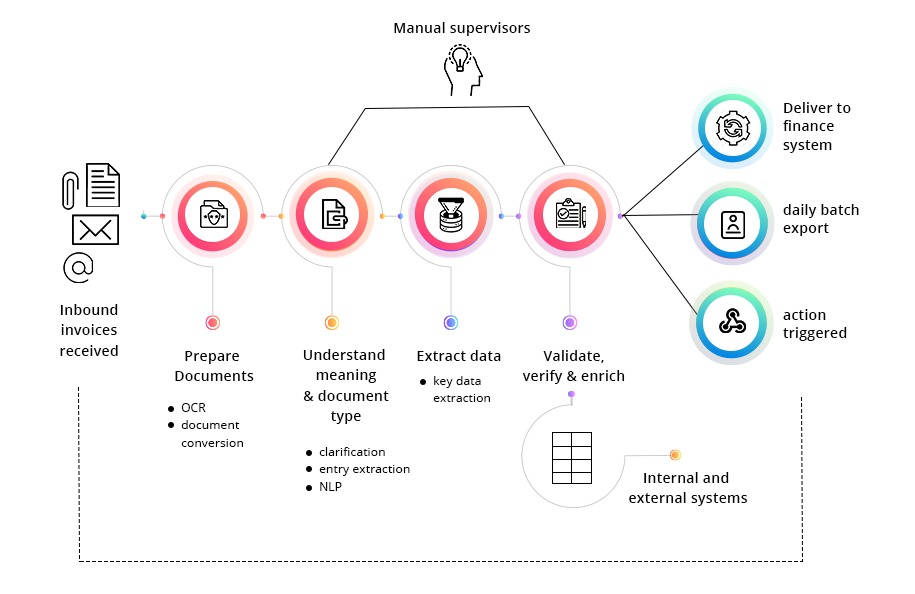
Paper-driven processes for logistic companies consumes about 10.6 days to fully process one invoice. This involves manual tasks of collecting, sorting, routing and matching a large number of documents from different locations. It is a tedious task whether you outsource it or do it in-house. The very tediousness creates the potential for errors creeping it. Machine learning in supply chain offers a more efficient way to process invoices using intelligent automation technologies
The benefits of automated invoice processing
Machine Learning algorithms is more than a buzz word in the logistic sector. The chances are that if you are shipping goods then you have already had the benefit of machine learning technology. Machine learning and predictive analysis are bringing a revolution with all industries becoming more automated in every way.
Full human dependency in invoicing and data entry will not be sustainable in the near future and businesses that do not integrate new technology will find it difficult to compete in the wafer-thin business margins.
Here are some of the benefits of machine learning in logistics data entry that are worth evaluating
Benefits of automated invoice processing
1. Eliminates human error: Of course, this is the big one, since using data entry automation improves accuracy and reduces payment errors. Unlike a human, an automated system is never going to get bored with repetitive tasks and hence does not get careless. In fact, it can complete the task with a 99% accuracy rate – same as a human but in less time.
2. Saves time: With automation what could take days is essentially reduced man hours. When best in-class machine learning solutions are in place then a single invoice is processed in 3.6 days compared to greater than 10 days. This allows the company with faster processes to offer early pay discounts
3. Saves cost: Extraction of invoice data, matching the data with purchase orders and receipts, assigning distribution codes etc. are automated and this means a major saving on labor costs. In fact, statistics show that if the AP process is automated then it will cost 85% less than if continues to be manual.
The process involved in machine learning in logistics for Invoice billing
Invoice processing is a smaller part of the whole accounting process. Most companies have digitized it but it essentially involved replacing pen and ink with the computer. You still have a human working on a machine to complete the process. Machine Learning will automate the process, referring exceptions to a human and then this exception and solution is fed back in and the algorithm learns and handles it in the next occurrence.

Invoice capture is extracting data and converting it to a structured form. It is the first part of automating the back-office process and many companies start with this as the initial step. Invoice capture differs from OCR in that it does not just capture the data but it also identifies key-value pairs and creates tables which is the base for auto processing invoices.
Not all invoices are prepared in the same manner, therefore machine learning algorithms must be trained to recognize the mandatory fields such as invoice number, net/gross amounts, tax, etc. There must be sufficient amount of historical data to use as examples for the algorithm to learn from and the different formats/data field types to recognize.
AI powered software scans and reads data if it is on paper or read all the characters and numbers from an electronic invoice. Natural Language Processing (NLP) is a form of Machine Learning that is speeding up data entry into standardized formats.
Step 2:Data extraction
In finance and book keeping any error can have a snowballing effect. This is why the data extracted through machine learning algorithm should include a manual reviewing process. Normally, only exceptions would go to a supervisor and this could also be part of the process unless new invoice formats are being fed into the system.
Step 3: Invoice generation
This step can be automated if needed but supply chain businesses can still keep it manual or semi-automated. If vendor systems are integrated then automating the complete cycle can make the process quicker and easier.

How to choose your development partner for ML
Data privacy policies might not allow using external APIs. While choosing your partner look for flexible solutions for deployment options. A provider should provide consistent data structures so that processing as well as analytics is easier. Finally, run a Proof of Concept (PoC) and compare it to false positives rates (invoices that are auto-processed but have errors).
iTechIndia has partnered with countries across the globe to provide cutting-edge technology to solve business challenges. We have delivered solutions in reengineering, custom software, machine learning, and data lake creation. If you have questions feel free to Contact us or chat with us here.







